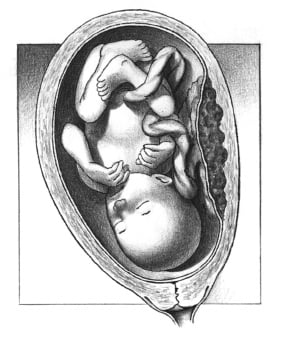5. The Umbilical Cord
The umbilical cord is the connection
between your baby and the placenta. It is usually about 24 inches
(60cm) long. The cord is gray or white, coiled or lumpy, and contains
two arteries to carry baby’s blood to the placenta, where it absorbs
oxygen and nutrients. A vein in the umbilical cord carries blood and
nutrients back to the baby.

Rarely knots form in an umbilical cord.
Experts believe knots form as the baby moves around early in pregnancy.
A loop forms in the umbilical cord, and when the baby moves through the
loop, a knot is completed. You can’t do anything to prevent it.
You may have heard about saving blood
from your baby’s umbilical cord for future use or for donation for use
by others.
6. The Amniotic Sac
The amniotic sac is a bag inside your
uterus that contains your baby and the amniotic fluid surrounding it.
Early in pregnancy, amniotic fluid comes from the amniotic membrane
covering the placenta and cord. Later in pregnancy, the fluid is mainly
composed of fetal urine and fluid excreted by fetal lungs.
As your pregnancy progresses, the amount
of amniotic fluid produced increases. This continues until close to the
time of delivery, when it begins to decrease.
Amniotic fluid keeps the sac from
collapsing and enables the baby to move around so muscles and joints
can develop. Fluid regulates temperature and cushions the fetus from
injury. It also helps a baby’s lungs to mature, as fluid passes into and out of fetal lungs when the baby’s chest moves in and out in a type of “breathing.”
By 21 weeks, the fetal digestive system
has developed enough to enable the fetus to swallow amniotic fluid. The
fetus absorbs much of the water contained in the swallowed fluid.
Swallowing amniotic fluid may encourage
development of the fetal digestive system. It may condition the
digestive system to function after birth. By term, a baby may swallow
large amounts of amniotic fluid—as much as 17 ounces (500ml) of
amniotic fluid in a 24-hour period.
Amniotic fluid is an important gauge of
fetal well-being. If you have amniocentesis, amniotic fluid is removed
from your uterus for study. The amount of fluid can also be an
indication of fetal health; ultrasound is used to evaluate the amount
of fluid in the sac. Too much fluid may indicate a malformation in the
spinal cord or digestive system. Too little may signal fetal bladder or
kidney problems.
7. The Presence of Meconium
The term meconium refers to
undigested debris from swallowed amniotic fluid in the fetal digestive
system. Meconium is a greenish-black to light-brown substance your baby
may pass from its bowels into amniotic fluid. This can happen before or
at the time of delivery.
The presence of meconium in amniotic
fluid may be caused by fetal stress, although not always. The baby can
swallow meconium in the amniotic fluid just before birth or at the time
of birth. If inhaled into the lungs, meconium may cause pneumonia or
pneumonitis.
Meconium can be detected when
your water breaks. Before then, the only way to know about it is by
amniocentesis. If meconium is present at delivery, an attempt is made
to remove it from the baby’s mouth and throat with a small suction tube
so the baby won’t swallow it.